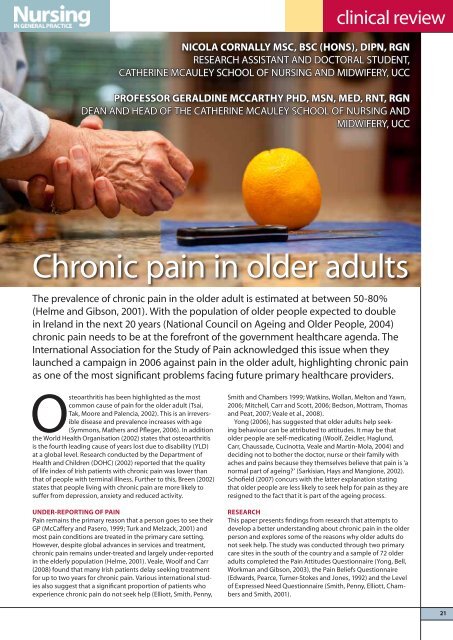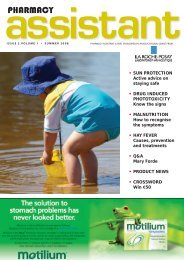veNTIlATIoN - Green Cross Publishing
veNTIlATIoN - Green Cross Publishing
veNTIlATIoN - Green Cross Publishing
You also want an ePaper? Increase the reach of your titles
YUMPU automatically turns print PDFs into web optimized ePapers that Google loves.
clinical review<br />
NIcolA corNAlly msc, bsc (hoNs), dIPN, rgN<br />
RESEARCH ASSISTANT AND DOCTORAL STUDENT,<br />
CATHERINE MCAULEy SCHOOL OF NURSING AND MIDWIFERy, UCC<br />
ProFessor gerAldINe mccArThy Phd, msN, med, rNT, rgN<br />
DEAN AND HEAD OF THE CATHERINE MCAULEy SCHOOL OF NURSING AND<br />
MIDWIFERy, UCC<br />
Chronic pain in older adults<br />
The prevalence of chronic pain in the older adult is estimated at between 50-80%<br />
(Helme and Gibson, 2001). With the population of older people expected to double<br />
in Ireland in the next 20 years (National Council on Ageing and Older People, 2004)<br />
chronic pain needs to be at the forefront of the government healthcare agenda. The<br />
International Association for the Study of Pain acknowledged this issue when they<br />
launched a campaign in 2006 against pain in the older adult, highlighting chronic pain<br />
as one of the most significant problems facing future primary healthcare providers.<br />
Osteoarthritis has been highlighted as the most<br />
common cause of pain for the older adult (Tsai,<br />
Tak, Moore and Palencia, 2002). This is an irreversible<br />
disease and prevalence increases with age<br />
(Symmons, Mathers and Pfleger, 2006). In addition<br />
the World Health Organisation (2002) states that osteoarthritis<br />
is the fourth leading cause of years lost due to disability (yLD)<br />
at a global level. Research conducted by the Department of<br />
Health and Children (DOHC) (2002) reported that the quality<br />
of life index of Irish patients with chronic pain was lower than<br />
that of people with terminal illness. Further to this, Breen (2002)<br />
states that people living with chronic pain are more likely to<br />
suffer from depression, anxiety and reduced activity.<br />
uNder-rePorTINg oF PAIN<br />
Pain remains the primary reason that a person goes to see their<br />
GP (McCaffery and Pasero, 1999; Turk and Melzack, 2001) and<br />
most pain conditions are treated in the primary care setting.<br />
However, despite global advances in services and treatment,<br />
chronic pain remains under-treated and largely under-reported<br />
in the elderly population (Helme, 2001). Veale, Woolf and Carr<br />
(2008) found that many Irish patients delay seeking treatment<br />
for up to two years for chronic pain. Various international studies<br />
also suggest that a significant proportion of patients who<br />
experience chronic pain do not seek help (Elliott, Smith, Penny,<br />
Smith and Chambers 1999; Watkins, Wollan, Melton and yawn,<br />
2006; Mitchell, Carr and Scott, 2006; Bedson, Mottram, Thomas<br />
and Peat, 2007; Veale et al., 2008).<br />
yong (2006), has suggested that older adults help seeking<br />
behaviour can be attributed to attitudes. It may be that<br />
older people are self-medicating (Woolf, Zeidler, Haglund,<br />
Carr, Chaussade, Cucinotta, Veale and Martin-Mola, 2004) and<br />
deciding not to bother the doctor, nurse or their family with<br />
aches and pains because they themselves believe that pain is ‘a<br />
normal part of ageing?’ (Sarkisian, Hays and Mangione, 2002).<br />
Schofield (2007) concurs with the latter explanation stating<br />
that older people are less likely to seek help for pain as they are<br />
resigned to the fact that it is part of the ageing process.<br />
reseArch<br />
This paper presents findings from research that attempts to<br />
develop a better understanding about chronic pain in the older<br />
person and explores some of the reasons why older adults do<br />
not seek help. The study was conducted through two primary<br />
care sites in the south of the country and a sample of 72 older<br />
adults completed the Pain Attitudes Questionnaire (yong, Bell,<br />
Workman and Gibson, 2003), the Pain Beliefs Questionnaire<br />
(Edwards, Pearce, Turner-Stokes and Jones, 1992) and the Level<br />
of Expressed Need Questionnaire (Smith, Penny, Elliott, Chambers<br />
and Smith, 2001).<br />
21










